Menus
- 125cc supermotos in comparison
- Conclusion
- Aprilia SX 125 SM
- Beta RR 125 Motard
- Derbi Senda DRD 125 SM
- Husqvarna SMS 4
- Yamaha WR 125 X
- power
- Price comparison of the 125 supermoto bikes
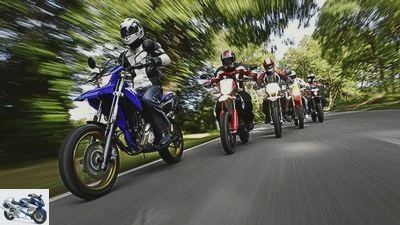
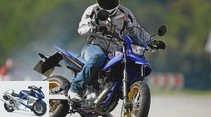
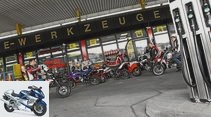

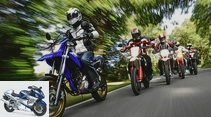
20th photos
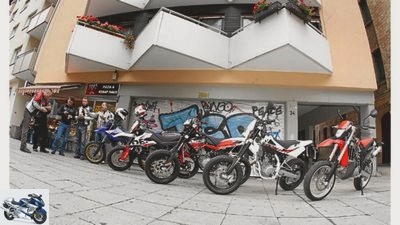
1/20
Successful appearance: With all five supermotos you can be seen anywhere without hesitation.

2/20
The Yamaha WR 125 X is best processed and offers the best brakes and the best equipment. The handy WR is also a lot of fun.
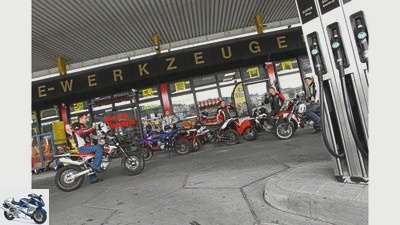
3/20
Short drinking break for man and machine at the gas station before the test begins.
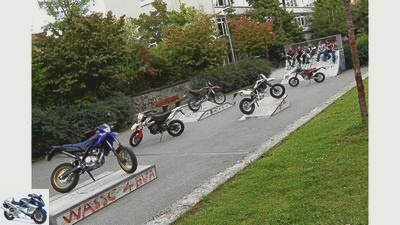
4/20
A rare sight: just lounging around is not – the 125s encourage driving.
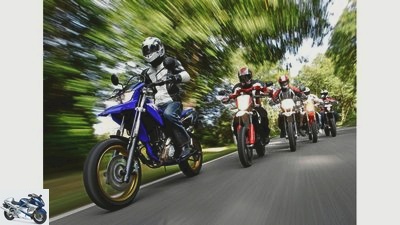
5/20
Little supermotos for great fun. You could think that only youngsters climb the 125cc, but the not very young testers are almost dying for the supermotos.
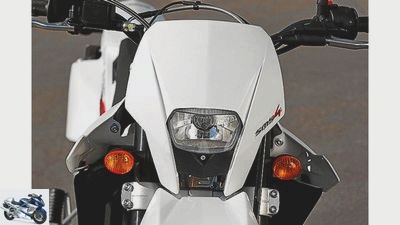
6/20
The standard front mask of the Husky is like one of the accessories with a small, moderately bright headlight.
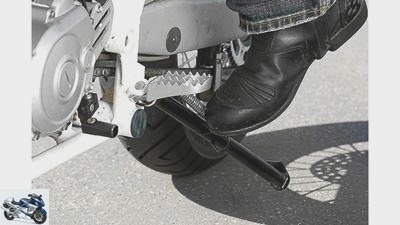
7/20
One of the few annoyances with the Husqvarna: the rather fiddly, difficult to fold out side stand.
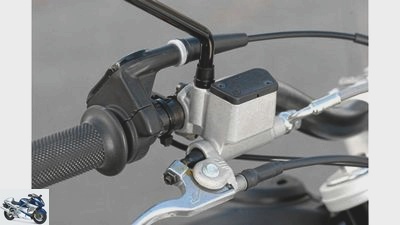
8/20
The Derbi’s delicate brake armature transmits the pressure to the steel braided lines, but the somewhat blunt brake is not really easy to dose.
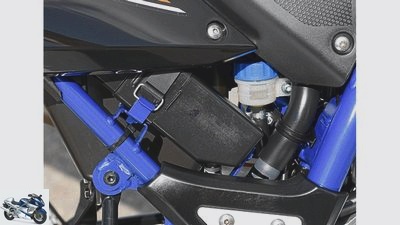
9/20
Easily accessible: The tool box is in the frame triangle and contains an amazingly extensive range.
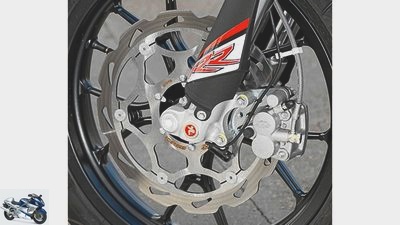
10/20
The front brake with the filigree brake disc heats up after a few violent braking until it fails completely.
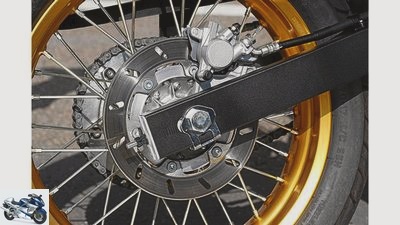
11/20
The simple chain tensioner and the steel box swing arm express the high standard of equipment.
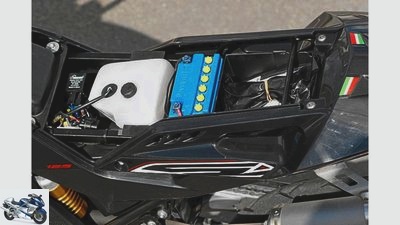
12/20
Tidy: The battery and the tank for the essential two-stroke oil are easily accessible under the seat.
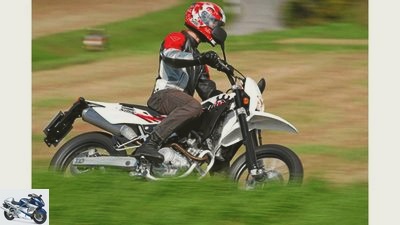
13/20
Although the Husqvarna SMS 4 was denied victory, the best chassis and great handiness make the Husky the most balanced joker in comparison.
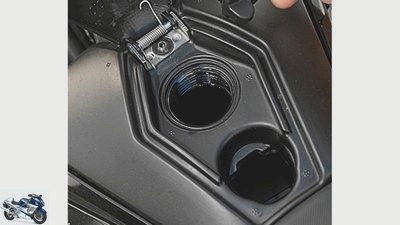
14/20
Unfolded: The screwed tank cap of the Beta is under the lid.
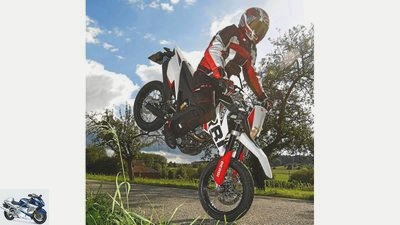
15/20
The Derbi Senda DRD 125 SM is sluggish and has a long translation. The shortcoming of the engine cannot be corrected by handling and equipment.
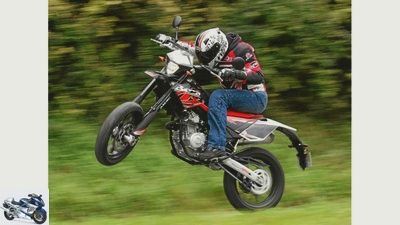
16/20
Unfortunately, the Beta RR 125 Motard offers few advantages apart from the powerful and at the same time economical engine.
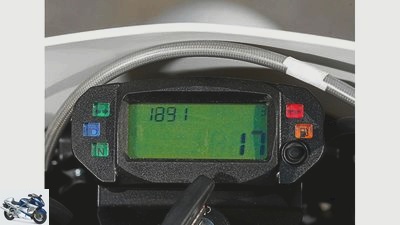
17/20
In the sparse cockpit of the Derbi Senda, at least large, bright warning lights shine. Sometimes, however, neutral is signaled despite an engaged gear.

18/20
Depending on the mode selected, the SX is the only one to provide information about the speed in the large display.
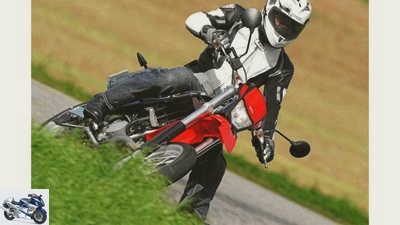
19/20
The Aprilia SX 125 Supermoto impresses with its extremely stable chassis, great brakes and a characteristic engine, but unfortunately the Aprilia is a little expensive.
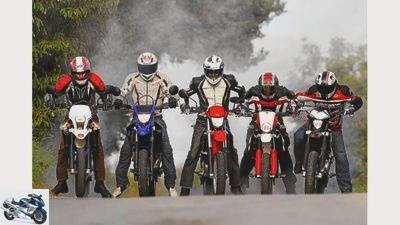
20/20
In the comparison test, the Aprilia SX 125 SM, the Beta RR 125 Motard, the Derbi Senda DRD 125 SM, the Husqvarna SMS 4 and the Yamaha WR 125 X compete against each other.
Comparison test: 125cc supermotos
125cc supermotos in comparison
Better across than heavy. The light and nimble supermotos tempt you to brisk hustle and bustle and cheeky drifts. Which of the 15 hp 125 cc is the most fun in everyday life?
Old, rich sacks and young, pretty things – a widespread, often observed combination. Not only in celebrity and aristocratic circles. Blasphemy mouths in the editorial office are sure to run this association through their heads when they see the test crew moving out. Seasoned, performance-spoiled testers, some well over, ahem, 20, with five (at first glance) gorgeous 125cc supermoto – how does that fit together? Very well. After just a few kilometers, it becomes clear once again that driving pleasure does not necessarily, and certainly not primarily, depend on engine power, and that even hardened bikers turn into pubescent boys again when they are let loose on lively 125ccs that need to be squeezed out.
Speaking of young age: the youngest candidates are Derbi, Beta and Husqvarna, they have only been trying to entice potential buyers since the beginning or middle of this year. Yamaha and Aprilia, on the other hand, are almost old but experienced boxes. The fact that you can learn something from the older ones and like to imitate them is evident not only in the similar, sleek design of the colorful plastic parts, but also when looking at the inner values: Beta and Husqvarna use the water-cooled Yamaha engine, but feed it by carburetor instead of injection. D.erbi relies on the four-valve engine from Piaggio, which is already used in various sister models, the Aprilia is the only one to hold the two-stroke flag with its proven single-cylinder from the RS 125. The Italian is also the only one who still wants to be brought to life with a kick, which is usually achieved with the help of choke and a courageous kick at the latest on the third attempt.
Buy complete article

Comparison test: 125cc supermotos
125cc supermotos in comparison
WR 125 X is the model boy here, both in terms of sound and in terms of running smoothness. However, a proud 910 millimeter seat height has to be climbed first – the highest value in the group.
Little supermotos for great fun. You might think that only youngsters climb the 125cc, but the not very young testers are almost dying for the supermotos.
In return, the Japanese pampers the driver with a comfortable seating arrangement, a rather lavishly equipped cockpit and the most adult appearance overall. The WR would easily go through at least as 250cc even while standing. Its high quality equipment / workmanship is one side of the coin, the heavy weight of at least 144 kilograms is the other. Initial inner-city traffic light duels, however, depend more on the skillful engagement and timely shifting than on excess pounds. Where the beta, for example, requires early gear changes because its engine has the heartiest thump all the way down, but is not very revving, the toxic Aprilia has to be carefully engaged at high speed for official propulsion and always kept in the narrow range between 7000 and a good 9000 tours . Two-stroke rolling is also possible with less speed, but power only comes from 6000 rpm, real bite only from 7000 rpm.
The Husky is not a pulling miracle either and, like all the others (more or less serious), is geared too long, but it gets down to business with sufficient force from medium speeds. The same applies to the Derbi. With the Spaniard, however, the somewhat long gearshift travel interferes with the pleasure of changing gears, which are essential for speedy progress. With 16.7 seconds she even had to admit defeat to the narrow-chested two-stroke Aprilia, which is known in this discipline. If you are right to suspect when looking at the thinly upholstered Aprilia bench there is hardly any seating comfort, it still turns out to be a litter when you switch from the Derbi. Their saddle sat through in no time, even lightweights flatten the upholstery and feel the frame tubes underneath all too clearly. The same applies to the beta, although the driver also has to suffer from the unconventional sitting posture. The pilot sits down here, stretches his arms towards the handlebars, which are mounted quite high, and at the same time has to bend his legs sharply – the Supermoto posture actually looks different. After a bit of getting used to it, you can shoo the beta around the corner, but due to the lack of feedback and confidence in the front wheel, it leaves a stale aftertaste.
Small drinking break for man and machine at the gas station during the test.
Husqvarna and Yamaha show how it can be done better: sufficiently comfortable padded benches, the pilot sits close to the wide handlebars, comfortable leg angles – that fits. Above all on the SMS 4, the driver immediately feels that he is in good hands and develops confidence in the tight, but not too rigid, suspension. The softly designed Yamaha is a bit more comfortable, but this leads to clear movements in the front when the driving style is more severe. The fork is deeply immersed and impairs steering behavior, but on the other hand it also smooths out a lot of things that the competition relentlessly passes on to the driver. It is always astonishing how easily the heavy WR 125 X circles through tight, slow corners. It only becomes a little slower than the competition at high speeds. The Aprilia offers its very own driving experience. On the one hand, it is extremely stable and precise in curves of all kinds, immediately instilling unlimited confidence, and its set-up proves to be extremely successful. On the other hand, the lightweight SX turns in extremely lightly, but also gives the impression of pushing the front wheel far away and always wanting to make a little more turns.
Far away? Long distances? Better not with the Aprilia. This is not what it is made for, and would then have to always have a gas pump with you anyway. Even the country road value of four liters per 100 kilometers determined with a moderate driving style gives an idea of the peak consumption when the going gets tough. You won’t get very far with the ten-liter tank, the SX is extremely thirsty. Speaking of thirst: the first test driver feels one "subtle feeling of hunger", So off to the city center for a kebab shop that you can trust. Squeaking and drifting, as befits the type of vehicle, the crew parks the five 125 cc in front of the entrance. Small annoyances of everyday life are revealed again here, such as the side stand on the Husqvarna, which can only be folded out with a lot of tip-toe, and the side stand on the Derbi, which does not automatically fold back because the spring is too lame. Freshly strengthened, it will soon be back on the expressway out of town. Here the large frontal area of the tall Yamaha takes revenge, on which the pilot offers the airstream the largest surface to attack.
Together with the long gear ratio, this gives the WR driver no chance to stay with the pack. The top speeds of 110 km / h measured under ideal conditions are history with the slightest gust of wind or slight ascent. The pace drops, once the slipstream is lost, the WR driver never comes back.
Successful appearance: With all five supermotos you can be seen anywhere without hesitation.
This is the hour for Aprilia, which tries to pull away with the highest top speed of 114 km / h, followed and pushed by the rest of the gang. The exit is finally in sight, the Yamaha is catching up again, and we continue on winding streets that wind through picturesque vineyards. However, none of the 125 cc drivers have the beauty of the surroundings in mind, but the knife between their teeth. All of them have long since mutated mentally into 16-year-old daredevils, including all adolescent behaviors. In hot hill climbs, the Aprilia driver in particular must not allow himself to make any shifting errors due to his narrow usable speed range and must carefully sort the gears. The Beta sometimes roars out of the curve with too little speed, without starving to death in terms of performance, Yamaha and Husky fully exploit their balance and maneuverability here.
The downhill turns that soon follow reveal completely different strengths and weaknesses: where the WR 125 X unmovedly also completes the umpteenth brutal braking before the bend without complaint, the Beta goes to its knees in two ways: First, the barely damped fork always plunges mercilessly deep , sometimes up to the stop, and secondly, the effect of the brake, which heats up very quickly, decreases dramatically, up to total failure after the fifth quasi-emergency braking. Questionable. The Aprilia is almost as stable as the Yamaha, followed by the Husqvarna, whose brakes show only slight, not really problematic fading, i.e. decreasing braking effect. The dull, appealing, moderately dosed all-or-nothing stoppers from Derbi leave a somewhat bland impression: not really bad, but not great either. Should this formulation already anticipate the overall judgment for the Derbi? At the end of a long day with fooling around, traffic light duels, jostling, drifts and wheelies, everyday testing forces you to return to the sober world of mature adults. There are transfigured looks and the question: Husky, Yamaha and Co. – where were you when we were 16?
Conclusion
A rare sight: just lounging around is not – the 125s encourage driving.
1st place: Yamaha WR 125 X
A victory of reason? The well-made Yamaha offers the best brakes and the best equipment. The handy WR is also a lot of fun.
2nd place: Husqvarna SMS 4
The winner of hearts. The best chassis and great maneuverability make the Husky the first choice when the going gets tough. The most balanced joker in comparison.
3rd place: Aprilia SX 125 Supermoto
You have to like the two-stroke characteristics, but the bite of the engine can be addicting. The light SX 125 offers great brakes and an extremely stable chassis.
4th place: Derbi Senda DRD 125 SM
Limp in the draft, geared too long and not even economical – the Derbi cannot score with the engine. Handling and equipment do not tear it out.
5th place: Beta RR 125 Motard
The powerful, powerful and economical engine is pretty much the only trump card of the Beta. Brakes, processing and chassis give her the red lantern.
MOTORCYCLE scoring
Category engine:
Pressure from below: The pulling power from low revs and the brave, at least the second-highest top speed help the beta win in the engine chapter. The motor donor Yamaha cannot counteract despite the injection and cultivated manners – it suffers, like the Husqvarna, from its long gear ratio. The Derbi does not uproot trees anywhere.
Winner engine: Beta
Category chassis:
Confident and balanced: With its tight, but not too hard and therefore everyday chassis set-up and great handiness, the SMS 4 wins here. The Beta loses a lot of points because of its criminally weak fork.
Chassis winner: Husqvarna
Category Security:
Victory of reason: with flawless brakes, good visibility in the mirrors and proper light, the Japanese shows how it’s done. At Beta you should urgently revise the brakes.
Safety winner: Yamaha
Category everyday life:
Hardly okay: Despite the highest weight in comparison, the Yamaha takes the lead here too, together with the light Aprilia. The tightly padded benches by Beta and Derbi lack comfort, which is a problem for the driver’s rear.
Winner everyday: Aprilia / Yamaha
Category costs:
One thing is clear: the best workmanship, the lowest consumption, all at the lowest price – the WR 125 X is the cost queen. The fact that the beta consumes just as little does not save the rather expensive Italian in view of her mediocre performance.
Winner cost: Yamaha
| Max. | Aprilia | beta | Derbi | Husqvarna | Yamaha | |
| Overall rating | 125 | 76 | 63 | 69 | 82 | 88 | placement | 3. | 5. | 4th. | 2. | 1. |
Winner price-performance:
The Yamaha is the most mature motorcycle in this 125cc comparison. It offers a high level of service in almost every category at the lowest price.
Aprilia SX 125 SM
The Aprilia SX 125 SM
| engine | |
| design type | Single cylinder two-stroke engine | Injection / carburetor | Ø 28 mm |
| coupling | Multi-disc oil bath clutch | Bore x stroke | 54.0 x 54.5 mm |
| Displacement | 125 cm3 | power | 11.0 kW (15 PS) at 8500 rpm | landing gear | frame | Double loop frame made of steel |
| fork | Upside-down fork, Ø 40 mm | Brakes front / rear | Ø 260 mm / Ø 220 mm |
| tires | 110/70 17; 150/60 17 | Tires | Pirelli Diablo | mass and weight | wheelbase | 1480 mm |
| Front / rear suspension travel | 260/270 mm | Seat height 1 | 880 mm |
| Weight with full tank 1 | 125 kg | Tank capacity / reserve | 10/3 liters |
| price | 4499 euros | 80 km / h throttling | free of charge | Readings | Top speed | 114 km / h |
| acceleration | 0-50 km / h | 3.7 |
| 0-80 km / h | 7.7 | Draft |
| 50-80 km / h | 13.0 | consumption |
| Consumption road | 4.0 liters / super | Reach country road | 250 km |
Beta RR 125 Motard
The Beta RR 125 Motard
| engine | |
| design type | Single cylinder four-stroke engine | Injection / carburetor | Ø 30 mm |
| coupling | Multi-disc oil bath clutch | Bore x stroke | 52.0 x 58.6 mm |
| Displacement | 124 cm3 | power | 11.0 kW (15 PS) at 8100 rpm | landing gear | frame | Double loop frame made of steel |
| fork | Upside-down fork, Ø 41 mm | Brakes front / rear | Ø 300 mm / Ø 270 mm |
| tires | 110/80 17; 130/70 17 | Tires | Michelin Pilot Sporty | mass and weight | wheelbase | 1439 mm |
| Front / rear suspension travel | 260/270 mm | Seat height 1 | 890 mm |
| Weight with full tank 1 | 118 kg | Tank capacity / reserve | 7/2 liters |
| price | 4399 euros | 80 km / h throttling | 110 euros plus installation | Readings | Top speed | 107 km / h |
| acceleration | 0-50 km / h | 4.3 |
| 0-80 km / h | 9.3 | Draft |
| 50-80 km / h | 8.7 | consumption |
| Consumption road | 2.9 liters / normal | Reach country road | 252 km |
Derbi Senda DRD 125 SM
The Derbi Senda DRD 125 SM
| engine | |
| design type | Single cylinder two-stroke engine | Injection / carburetor | Ø 28 mm |
| coupling | Multi-disc oil bath clutch | Bore x stroke | 56.0 x 50.7 mm |
| Displacement | 125 cm3 | power | 11.0 kW (15 hp) at 8250 rpm | landing gear | frame | Bridge frame made of aluminum |
| fork |
Upside-down fork, Ø 40 mm | Brakes front / rear | Ø 300 mm / Ø 180 mm |
| tires | 110/80 17; 140/70 17 | Tires | Vee Rubber | mass and weight | wheelbase | 1355 mm |
| Front / rear suspension travel | 120/110 mm | Seat height 1 | 880 mm |
| Weight with full tank 1 | 135 kg | Tank capacity / reserve | 8/0 liters |
| price | 4548 euros | 80 km / h throttling | 99 euros plus installation | Readings | Top speed | 104 km / h |
| acceleration |
0-50 km / h | 4.8 |
| 0-80 km / h | 11.4 | Draft |
| 50-80 km / h | 16.7 | consumption |
| Consumption road | 3.6 liters / normal | Reach country road | 222 km |
Husqvarna SMS 4
The Husqvarna SMS 4
| engine | |
| design type | Single cylinder four-stroke engine | Injection / carburetor | Ø 29 mm |
| coupling | Multi-disc oil bath clutch | Bore x stroke | 52.0 x 58.6 mm |
| Displacement | 124 cm3 | power | 11.0 kW (15 hp) at 8750 rpm | landing gear | frame | Double loop frame made of steel |
| fork | Upside-down fork, Ø 40 mm | Brakes front / rear | Ø 260 mm / Ø 220 mm |
| tires | 110/70 17; 140/70 17 | Tires | Pirelli Sport Demon | mass and weight | wheelbase | 1465 mm |
| Front / rear suspension travel | 260/282 mm | Seat height 1 | 880 mm |
| Weight with full tank 1 | 127 kg | Tank capacity / reserve | 9/1 liter |
| price | 4190 euros | 80 km / h throttling | approx. 100 euros plus installation | Readings | Top speed | 110 km / h |
| acceleration | 0-50 km / h | 3.9 |
| 0-80 km / h | 9.8 | Draft |
| 50-80 km / h | 14.5 | consumption |
| Consumption road | 2.9 liters / normal | Reach country road | 293 km |
Yamaha WR 125 X
The Yamaha WR 125 X
| engine | |
| design type | Single cylinder four-stroke engine | Injection / carburetor | Ø 28 mm |
| coupling | Multi-disc oil bath clutch | Bore x stroke | 52.0 x 58.6 mm |
| Displacement | 124 cm3 | power | 11.0 kW (15 PS) at 9000 rpm | landing gear | frame | Double loop frame made of steel |
| fork | Telescopic fork, Ø 41 mm | Brakes front / rear | Ø 298 mm / Ø 220 mm |
| tires | 110/70 17; 140/70 17 | Tires | Pirelli Sport Demon | mass and weight | wheelbase | 1430 mm |
| Front / rear suspension travel | 210/230 mm | Seat height 1 | 910 mm |
| Weight with full tank 1 | 144 kg | Tank capacity / reserve | 9/0 liters |
| price | 4030 euros | 80 km / h throttling | 179.95 euros plus installation | Readings | Top speed | 110 km / h |
| acceleration | 0-50 km / h | 4.4 |
| 0-80 km / h | 10.8 | Draft |
| 50-80 km / h | 12.2 | consumption |
| Consumption road | 2.9 liters / normal | Reach country road | 291 km |
power
Drawing: archive
The performance diagram of the five supermotos.
If you have to do a lot, you have to drink a lot? The performance curves (right) reflect the driving impression: The Aprilia only comes down to business at 6500 rpm, but clearly exceeds the permitted 15 hp. The Derbi represents the motto "nothing below and little above", the Yamaha has the most even performance curve.
Price comparison of the 125 supermoto bikes
Used 125cc Supermoto in Germany
The 125 supermotos are compared to each other in a direct price comparison on the used motorcycle exchange. Definitely worth a look for all Supermoto fans: Used 125cc Supermoto in Germany
Related articles
-
Comparison test: high-speed test in Nardo
Jahn 42 pictures Jahn 1/42 Top handling and transparent feedback make the BMW S 1000 RR what it is. She also has a lot of electronic …
-
Comparison test: Aprilia, BMW, Husqvarna, KTM and Yamaha
fact comparison test: Aprilia, BMW, Husqvarna, KTM and Yamaha single-cylinder fun bikes They have a big heart, a very big one. The new…
-
Comparison test: The five newest 450cc sport enduros
Comparison test: Sports enduros The five newest 450 enduros in the test If you want to fly with the big ones, you have to do a lot in enduro …
-
Comparison test of 450 cc motocrosss
Motociclismo Comparison test 450 cc motocross 2011 Crossers from Honda, Kawasaki, KTM, Suzuki and Yamaha Ironically, in the top motocross class (MX1, 450…
-
KTM RC 125 and Yamaha YZF-R 125 in comparison test
Jahn 26 pictures Jahn 1/26 KTM RC 125 and Yamaha YZF-R 125 in comparison test. Jahn 2/26 KTM RC 125. Jahn 3/26 Yamaha YZF-R 125. Jahn 4/26 Yamaha YZF-R 125 ….
-
Comparison test of superbikes, part 1: Country road
Jorg Kunstle 36 pictures 1/36 Comparison test Superbikes: Aprilia RSV4 RF, BMW S 1000 RR, Kawasaki ZX-10R, Yamaha YZF-R1M. 2/36 …
-
Comparison test: athletes against touring athletes
25 pictures 1/25 Concept comparison: super athletes versus touring athletes from Honda and Kawasaki. In the test: Kawasaki Ninja ZX-10R, …
-
Jahn 35 pictures Jahn 1/35 Husqvarna TC 250 R in the motocross comparison test. Jahn 2/35 Yamaha YZ 250 F in the motocross comparison test. Jahn 3/35 Husqvarna TC …
-
Comparison test: 250cc motocross
Motociclismo Comparison test: 250 cc motocross 2011 The revised 250 cc Crosser in comparison If you don’t want to be sandblasted by your colleagues in…
-
Aprilia RSV4 RF and Yamaha YZF-R1M in comparison test
40 photos markus-jahn.com 1/40 Aprilia RSV4 RF and Yamaha YZF-R1M in comparison test. markus-jahn.com 2/40 You sit quite high on both bikes, but with the…